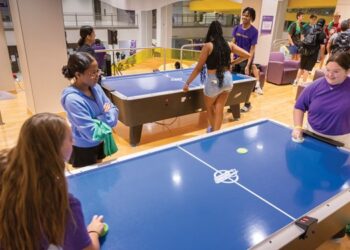Chasing trends in group fitness can be a hit or miss endeavor, but smaller classes with a specialized focus and boutique experience are only expanding. Are there opportunities for adapting your recreation center to create a better vibe to improve the success of these offerings?
The days of the large multi-purpose classroom are fading. These rooms can be re-positioned to create a series of smaller group fitness rooms, each with an environment that caters to the mood needed for a specialized experience. Beyond the ability to offer class variety at peak times, having multiple smaller rooms has several advantages.
Size matters. The connection between instructor and class participants is a primary driver in the dramatic success of boutique fitness. Tailoring rooms for a class size of 25 to 30 people allows for personal interaction and a better experience. This yields a room size of 2,000 square feet to accommodate traditional format group exercise. This same room size also lends itself to smaller, highly specialized classes with more space for movement to give room for new types of combined workout formats that offer creative ways to keep fitness fresh. For cycling, the area needed to store bikes is not much smaller than the 600 square feet needed for a dedicated cycling studio for a 25-person class.
Atmosphere matters. Specialized offerings need specialized rooms. The feel of the room has a dramatic impact on the experience of the class. Replacing the large catch-all multi-purpose room with two types of multi-purpose environments can support the mood for the two basic styles of group fitness; a quiet room with dimmable lighting and warm finishes creates the vibe for mind/body classes, and a bright room with “live” acoustics for high intensity, high impact classes. These two room styles can support many types of evolving specialized group offerings, but for cycling, a dedicated studio is essential to create the environment that supports the culture.
Technology matters. Wearable devices for activity and fitness tracking can add another level of measuring goals and results. Video screens in group studios can be linked to these devices to allow class participants to see real-time relative accomplishments and promote healthy competition and incentive. An emerging trend is providing a variety of virtual classes within the fitness club setting to combine the benefits of access to “celebrity” instructors with the camaraderie of being in the same room with your friends. If you have video screens it opens the door for your facility to provide these types of classes to expand the offerings and schedules, without adding instructors.
Trends can be allusive, but size, mood and technology are elements that can be adapted into almost any facility to create a flexible palette of room types that help to transform a workout into an experience.
Salvatore Canciello is a principal at S3 Design. He can be reached at scanciello@s3design-inc.com or visit s3design-inc.com.










